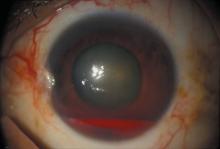The physician diagnosed hyphema—blood in the anterior chamber—which can be seen following eye trauma or as the result of clotting disturbances, vascular abnormalities, or mass effects from neoplasms. Traumatic hyphema occurs more often in boys and men and is often related to work or sports. In fact, 60% of hyphemas result from sports injuries.
Direct force to the eye (blunt trauma) forces the globe inward, distorting the normal architecture. Intraocular pressure rises instantaneously, causing the lens, iris, and ciliary body to move posteriorly. This disrupts the vascularization and results in bleeding.
Intraocular pressure continues to rise and bleeding stops when this pressure is high enough to compress the bleeding vessels. A fibrin-platelet clot forms and stabilizes in 4 to 7 days; this is eventually broken down by the fibrinolytic system and cleared through the trabecular meshwork.
An urgent referral is needed if there are concerns about globe rupture, elevated intraocular pressure, or other associated injuries.
A recent Cochrane review evaluated interventions that included antifibrinolytic agents, corticosteroids, cycloplegics, miotics, aspirin, conjugated estrogens, eye patching, head elevation, and bed rest. None of these significantly improves a patient’s visual acuity.
The patient in this case was referred urgently to ophthalmology and his eye was found to be otherwise healthy. He was given an eye shield for protection, advised to take acetaminophen for pain, and counseled not to engage in sporting activities until the hyphema resolved. In his case, it took 5 days.
Text for Photo Rounds Friday courtesy of Richard P. Usatine, MD. Photo courtesy of Paul Comeau. This case was adapted from: Chumley H. Eye trauma--hyphema. In: Usatine R, Smith M, Mayeaux EJ, et al, eds. Color Atlas of Family Medicine. 2nd ed. New York, NY: McGraw-Hill; 2013:159-162.
To learn more about the Color Atlas of Family Medicine, see: http://www.amazon.com/Color-Family-Medicine-Richard-Usatine/dp/0071769641/ref=dp_ob_title_bk
You can now get the second edition of the Color Atlas of Family Medicine as an app for mobile devices by clicking this link: http://usatinemedia.com/


